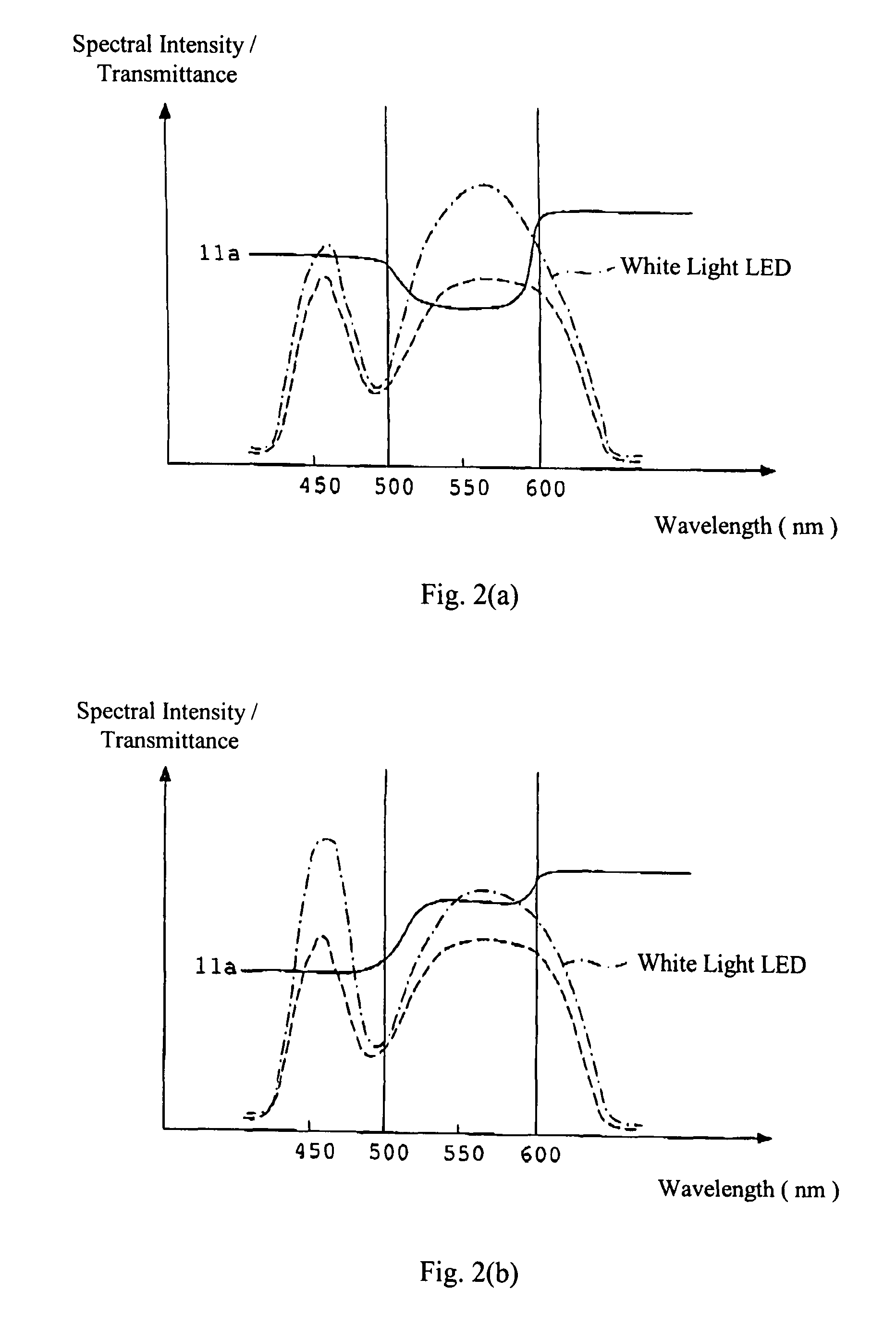Illumination optical system that uses a solid-state lighting element which generates white light, and an optical device equipped therewith
an optical system and light source technology, applied in the field of illumination optical systems, can solve the problems of increased burden on individuals who perform diagnoses, inconvenient operation, and erroneous diagnosis, and achieve the effects of reducing the cost of operation, and reducing the number of optical devices
- Summary
- Abstract
- Description
- Claims
- Application Information
AI Technical Summary
Benefits of technology
Problems solved by technology
Method used
Image
Examples
example 1
[0041]FIG. 2(a) shows the spectral intensity (i.e., light intensity as a function of wavelength) that is emitted by a first example of a white light LED (dot-dash line) that may be used in the illumination optical system shown in FIG. 1, the spectral transmittance of a first example of a wavelength distribution conversion element 11a (solid line) that may be used in the illumination optical system shown in FIG. 1, and the spectral intensity when the white light LED and the wavelength distribution conversion element 11a having the characteristics shown in FIG. 2(a) are used in combination (dash line) according to a first example of illumination optical system according to the present invention.
[0042]The wavelength distribution conversion element has a spectral transmittance profile that includes specified wavelength regions within which the transmittance is nearly constant with increasing wavelength so as to form a step of nearly even intensity, and has specified wavelength regions w...
example 2
[0044]FIG. 2(b) shows the spectral intensity that is emitted by a second example of a white light LED (dot-dash line) that may be used in the illumination optical system shown in FIG. 1, the spectral transmittance of a second example of a wavelength distribution conversion element 11a (solid line) that may be used in the illumination optical system shown in FIG. 1, and the spectral intensity of light output when the white light LED and the wavelength distribution conversion element 11a having the characteristics shown in FIG. 2(b) are used in combination (dash line) according to a second example of illumination optical system according to the present invention.
[0045]As shown in FIG. 2(b), the wavelength distribution conversion element 11a has a transmittance, within a specified wavelength region having wavelengths longer than approximately 500 nm and shorter than approximately 600 nm, that is higher than the transmittance of the wavelength distribution conversion element within a sp...
example 3
[0046]FIG. 3(a) shows the spectral intensity that is emitted by a third example of a white light LED (dot-dash line) that may be used in the illumination optical system shown in FIG. 1, the spectral transmittances of a first filter 11b1 and a second filter 11b2 that, in tandem, comprise a third example of a wavelength distribution conversion element in the illumination optical system shown in FIG. 1, and the spectral intensity of light output when the white light LED and the wavelength distribution conversion element having the characteristics shown in FIG. 3(a) are used in combination (dash line) according to a third example of illumination optical system according to the present invention. In this example as well as the next example, the wavelength distribution conversion element is formed of multiple filters that are positioned in tandem, one for each peak intensity emitted by the white light LED. As shown in FIG. 3(a) for this example, the wavelength distribution conversion elem...
PUM
 Login to View More
Login to View More Abstract
Description
Claims
Application Information
 Login to View More
Login to View More - R&D
- Intellectual Property
- Life Sciences
- Materials
- Tech Scout
- Unparalleled Data Quality
- Higher Quality Content
- 60% Fewer Hallucinations
Browse by: Latest US Patents, China's latest patents, Technical Efficacy Thesaurus, Application Domain, Technology Topic, Popular Technical Reports.
© 2025 PatSnap. All rights reserved.Legal|Privacy policy|Modern Slavery Act Transparency Statement|Sitemap|About US| Contact US: help@patsnap.com



